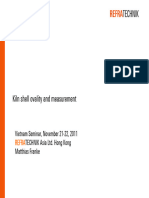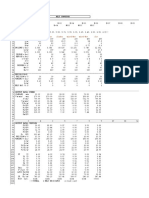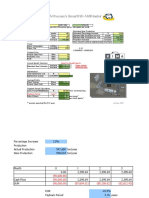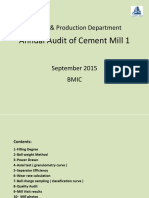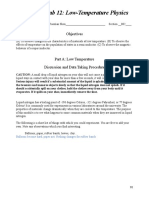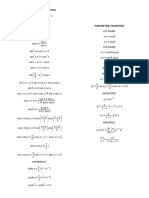Cement Process Engineering Vade Mecum: 2. Statistics
Cement Process Engineering Vade Mecum: 2. Statistics
Uploaded by
Tamer FathyCopyright:
Available Formats
Cement Process Engineering Vade Mecum: 2. Statistics
Cement Process Engineering Vade Mecum: 2. Statistics
Uploaded by
Tamer FathyOriginal Description:
Original Title
Copyright
Available Formats
Share this document
Did you find this document useful?
Is this content inappropriate?
Copyright:
Available Formats
Cement Process Engineering Vade Mecum: 2. Statistics
Cement Process Engineering Vade Mecum: 2. Statistics
Uploaded by
Tamer FathyCopyright:
Available Formats
CEMENT PROCESS ENGINEERING
VADE MECUM
2. STATISTICS
Rev. 2002
CEMENT PROCESS ENGINEERING
VADE-MECUM
SECTION 2 STATISTICS
Table of Contents
1. Descriptive Statistics ............................................................................... 2.1
1.1 Definitions .......................................................................................... 2.1
1.2 Basic .................................................................................................. 2.1
1.3 Normal Probability Distribution .......................................................... 2.1
1.4 Interval Estimation and Tables ............................................................ 2.2
2. Statistical Estimation Tests ..................................................................... 2.3
2.1 Generalities......................................................................................... 2.3
2.2 Test for the Equality of Two Variances ( 1 , 2 ) of two Normal
Population of Random Size, ( n1 , n 2 ) .................................................. 2.3
2.3 Fisher Distribution Table .................................................................... 2.4
3. Correlation Between Data Regression.................................................. 2.5
3.1 Generalities......................................................................................... 2.5
3.2 Least Squared Lines............................................................................ 2.5
4. Temporal/Regionalized Series (Variables) .............................................. 2.6
4.1 Stationnarity ....................................................................................... 2.6
4.2 Variogram .......................................................................................... 2.6
4.3 Raw Mix Control Tuning .................................................................... 2.9
5. Sampling ................................................................................................ 2.10
5.1 Golden Rules .................................................................................... 2.10
5.2 Fundamental Error (FE) .................................................................... 2.10
5.3 Minimum Representative Weight (MRW).......................................... 2.11
5.4 Estimation of the Maximum Particle Size .......................................... 2.11
5.5 Minimum Number of Observations.................................................... 2.12
5.6 Mechanical Sampling........................................................................ 2.12
5.7 Manual Sampling on Conveyor Belt .................................................. 2.13
Index - i
Rev. 2002
CEMENT PROCESS ENGINEERING
VADE-MECUM
SECTION 2 STATISTICS
1. Descriptive Statistics
1.1 Definitions
Statistics is the science of drawing conclusions about a population based on an analysis of sample data from
that population.
Population: values that can be taken by a variable.
Sample: drawing of n values of the variable taken from the population.
Random Variable = X = ( xi ) .
Probability Distribution = P ( xi ) . It describes the random variable probability of occurrence and is described
by its parameters. (Example: Normal distribution is described by and , see below).
Statistic = Any function of the sample data.
Estimator = An estimator of a parameter is a statistic, which corresponds to the parameter. For instance :
The sample mean ( x ) is the estimator of the actual population mean
The sample variance ( S 2 ) is the estimator of the actual population variance 2
Interval Estimation: An interval estimation of a parameter is the interval between 2 statistics that includes the
true value of the parameter with a given probability (1- ).
1.2 Basic
i =1
Arithmetical Mean = x =
2
Variance = S X
2
2
2
2
2 2
SX
+Y = S X + S Y and S aX = a S X
(x x)
n
Standard Deviation = S X =
a : Coefficient, X = ( xi ) , Y = ( yi ) : two series of independent values.
i =1
n 1
(x x )* ( y y)
Covariance = Average of the products of paired deviations: COV ( X ,Y ) = i =1
1.3 Normal Probability Distribution
The most often used probability distribution is the Normal probability distribution:
(
2
1 x x
)
2
dZ
1
=
e
dx 2
Central Limit Theorem
For a group of n independent sampling units drawn from a population of mean and variance 2 , the
sampling distribution of x =
x ,
1
n
i =1
x i is approximately Normal with mean and variance
2
. Said:
n
2.1
Rev. 2002
CEMENT PROCESS ENGINEERING
VADE-MECUM
SECTION 2 STATISTICS
1.4 Interval Estimation and Tables
a) If the Variance 2 is Known
The confidence interval, with a probability of (1- ), in which for any samples of the population with a given
unknown mean ( ) and known variance ( 2 ), the average x of the sample should range is given by:
x
2
x+
b) Normal Gauss Distribution Table
0.25
0.159
0.10
0.05
0.025
0.6745
1
1.28
1.64
1.96
0.0232
0.01
0.005
0.00135
0.001
2
2.32
2.57
3
3.09
Example:
Estimation of the true LHV mean ( ) of liquid waste fuel.
An n-size sample (n=100) of different waste fuel shipments gave a mean x = 5.5 MCal/kg. Standard deviation
of the waste fuel shipment population (considered infinite) is supposed to be 1Mcal/kg.
Then, according to the Central Limit Theorem, x follows a Normal distribution probability with a variance of
2
= 1 / 100 = 0.01 .
n
Thus, we are sure at 1 = 90% (then
[5.5 0.164 ,5.5 + 0.164] = [5.336 ,5.664] .
= 0.05 ) that the mean ( ) is between x 1.64 0.01 =
Remark:
If the population from which the sample is taken, is not infinite (lets say population size=800), then we have
to use a corrective factor of 1 n = 1 100
= 0.935 .
N
800
c) If the Variance 2 is Unknown and Sample Size n<30,
It has to be approximated by the variance S 2 of the sample. The Normal distribution is replaced by a t
distribution (Student distribution). The estimated interval, with a confidence of (1- ) and n-1 degree of
freedom, is given by:
S
S
x + t
x t
, n 1 n
, n 1 n
2
Example
With the data as above assuming S=1Mcal/kg, then with the same confidence (90%) and say 20 (21 samples)
degrees of freedom, ( ) is between: x 1.72 0.01 = [5.5 0.172 ,5.5 + 0.172] = [5.328 ,5.672] .
2.2
Rev. 2002
CEMENT PROCESS ENGINEERING
VADE-MECUM
SECTION 2 STATISTICS
d) Student Fisher Distribution Table
t 0.005 ,
t0.01,
t 0.025 ,
t 0.05 ,
t 0.10 ,
t 0.25 ,
t 0.45 ,
1
2
3
4
5
10
15
20
40
120
63.66
9.92
5.84
4.6
4.03
3.17
2.95
2.84
2.70
2.62
31.82
6.96
4.54
3.75
3.36
2.76
2.60
2.53
2.42
2.36
12.71
4.3
3.18
2.78
2.57
2.23
2.13
2.09
2.02
1.98
6.31
2.92
2.35
2.13
2.02
1.81
1.75
1.72
1.68
1.66
3.08
1.89
1.64
1.53
1.48
1.37
1.34
1.32
1.30
1.29
1
0.817
0.765
0.741
0.727
0.700
0.691
0.687
0.681
0.677
0.158
0.142
0.137
0.134
0.132
0.129
0.128
0.127
0.126
0.126
2. Statistical Estimation Tests
2.1 Generalities
A statistical hypothesis is a statement about the values of the parameters of a probability distribution.
Null hypothesis (H o ) : A = B , Alternative hypothesis (H 1 ) : A B .
To test a hypothesis, we take a random sample from the population under study, compute an appropriate test
statistic and then either reject or fail to reject ( H o ) with a risk of rejecting H o although H o is true.
2.2 Test for the Equality of Two Variances ( 1 , 2 ) of two Normal Population of Random
Size, ( n1 , n 2 )
(Excel Function FTEST)
Test Description
H o : 12 = 22 , H 1 : 12 22
We compute the statistic Fo =
We reject H o if Fo > F
2
Where
F
2
, n1 1, n2 1
S 12
S 22
, where F = Fisher Distribution
, n11, n2 1
or if Fo < F
and F
, n1 1, n2 1,
2
1 , n1 1, n2 1
2
denote the upper and lower
percentage points of the
F distribution with n1 1 and n2 1 degrees of freedom, respectively.
As the table for the F table gives only the upper tail points of the F, so to find F
, n1 1,n2 1
2
use: F
1 , n1 1, n2 1
2
1
F
2
we must
(be careful about n1 and n2 , which are inverted).
, n2 1, n1 1
2.3
Rev. 2002
CEMENT PROCESS ENGINEERING
VADE-MECUM
SECTION 2 STATISTICS
Example 1: Cement sampling:
We want to determine the best way of sampling cement. We can compare the variances of two sets of samples
collected at the mill discharge by two different ways. The H o hypothesis would be that there is no difference
between both ways of sampling (true variances equal). If the result says that according to the samples, there is
a difference, then the best sampling method could be the one with the lowest variance (one-sided alternative
hypothesis).
SSB measured:
#1 way: (4350, 4365, 4850, 4750, 4580, 4600, 4450, 4740),
#2 way: (4500, 4520, 4800, 4420, 4360, 4250, 4400, 4380)
H o : 12 = 22 , H 1 : 12 22 (two-sided alternative hypothesis)
(x 4586 )
8
After computing: x1 = 4586 , x 2 = 4454
S12 =
i =1
8 1
= 34796 , S 2 2 = 26598
34796
Fo =
= 1.308 < F0.05
= 4.99
26598
,8 1,8 1
and F.975 ,7 ,7 = ( F0.025,7 ,7 )
2
1
= ( 4.99 ) 1 = 0.20 <1.308
The test yields not to reject H o : the measurements dont allow us to conclude that #1 way of sampling is
significantly, with 5% confidence, different than #2 (even if S 1 > S 2 ). The excel function is FINV(0.025,7,7).
2.3 Fisher Distribution Table
(Calculated for the upper 2.5% of the F distribution (in our case, when = 5% )).
F(0.025, n1,n2)
1
1 647.79
2 799.48
3 864.15
4 899.60
5 921.83
6 937.11
7 948.20
8 956.64
9 963.28
10 968.63
15 984.87
20 993.08
25 998.09
30 1001.40
40 1005.60
50 1008.10
60 1009.79
70 1011.01
80 1011.91
90 1012.61
100 1013.16
200 1015.72
2
38.51
39.00
39.17
39.25
39.30
39.33
39.36
39.37
39.39
39.40
39.43
39.45
39.46
39.46
39.47
39.48
39.48
39.48
39.49
39.49
39.49
39.49
Ex: F(0.025,5,10)=4.24
3
4
5
6
17.44 12.22 10.01 8.81
16.04 10.65 8.43 7.26
15.44 9.98 7.76 6.60
15.10 9.60 7.39 6.23
14.88 9.36 7.15 5.99
14.73 9.20 6.98 5.82
14.62 9.07 6.85 5.70
14.54 8.98 6.76 5.60
14.47 8.90 6.68 5.52
14.42 8.84 6.62 5.46
14.25 8.66 6.43 5.27
14.17 8.56 6.33 5.17
14.12 8.50 6.27 5.11
14.08 8.46 6.23 5.07
14.04 8.41 6.18 5.01
14.01 8.38 6.14 4.98
13.99 8.36 6.12 4.96
13.98 8.35 6.11 4.94
13.97 8.33 6.10 4.93
13.96 8.33 6.09 4.92
13.96 8.32 6.08 4.92
13.93 8.29 6.05 4.88
7
8.07
6.54
5.89
5.52
5.29
5.12
4.99
4.90
4.82
4.76
4.57
4.47
4.40
4.36
4.31
4.28
4.25
4.24
4.23
4.22
4.21
4.18
8
7.57
6.06
5.42
5.05
4.82
4.65
4.53
4.43
4.36
4.30
4.10
4.00
3.94
3.89
3.84
3.81
3.78
3.77
3.76
3.75
3.74
3.70
9
7.21
5.71
5.08
4.72
4.48
4.32
4.20
4.10
4.03
3.96
3.77
3.67
3.60
3.56
3.51
3.47
3.45
3.43
3.42
3.41
3.40
3.37
10
6.94
5.46
4.83
4.47
4.24
4.07
3.95
3.85
3.78
3.72
3.52
3.42
3.35
3.31
3.26
3.22
3.20
3.18
3.17
3.16
3.15
3.12
15
6.20
4.77
4.15
3.80
3.58
3.41
3.29
3.20
3.12
3.06
2.86
2.76
2.69
2.64
2.59
2.55
2.52
2.51
2.49
2.48
2.47
2.44
20
5.87
4.46
3.86
3.51
3.29
3.13
3.01
2.91
2.84
2.77
2.57
2.46
2.40
2.35
2.29
2.25
2.22
2.20
2.19
2.18
2.17
2.13
25
5.69
4.29
3.69
3.35
3.13
2.97
2.85
2.75
2.68
2.61
2.41
2.30
2.23
2.18
2.12
2.08
2.05
2.03
2.02
2.01
2.00
1.95
30
5.57
4.18
3.59
3.25
3.03
2.87
2.75
2.65
2.57
2.51
2.31
2.20
2.12
2.07
2.01
1.97
1.94
1.92
1.90
1.89
1.88
1.84
40
5.42
4.05
3.46
3.13
2.90
2.74
2.62
2.53
2.45
2.39
2.18
2.07
1.99
1.94
1.88
1.83
1.80
1.78
1.76
1.75
1.74
1.69
50
5.34
3.97
3.39
3.05
2.83
2.67
2.55
2.46
2.38
2.32
2.11
1.99
1.92
1.87
1.80
1.75
1.72
1.70
1.68
1.67
1.66
1.60
60
5.29
3.93
3.34
3.01
2.79
2.63
2.51
2.41
2.33
2.27
2.06
1.94
1.87
1.82
1.74
1.70
1.67
1.64
1.63
1.61
1.60
1.54
70
5.25
3.89
3.31
2.97
2.75
2.59
2.47
2.38
2.30
2.24
2.03
1.91
1.83
1.78
1.71
1.66
1.63
1.60
1.59
1.57
1.56
1.50
80
5.22
3.86
3.28
2.95
2.73
2.57
2.45
2.35
2.28
2.21
2.00
1.88
1.81
1.75
1.68
1.63
1.60
1.57
1.55
1.54
1.53
1.47
90
5.20
3.84
3.26
2.93
2.71
2.55
2.43
2.34
2.26
2.19
1.98
1.86
1.79
1.73
1.66
1.61
1.58
1.55
1.53
1.52
1.50
1.44
100
5.18
3.83
3.25
2.92
2.70
2.54
2.42
2.32
2.24
2.18
1.97
1.85
1.77
1.71
1.64
1.59
1.56
1.53
1.51
1.50
1.48
1.42
200
5.10
3.76
3.18
2.85
2.63
2.47
2.35
2.26
2.18
2.11
1.90
1.78
1.70
1.64
1.56
1.51
1.47
1.45
1.42
1.41
1.39
1.32
2.4
Rev. 2002
CEMENT PROCESS ENGINEERING
VADE-MECUM
SECTION 2 STATISTICS
3. Correlation Between Data Regression
3.1 Generalities
Goal: express a dependant variable ( Y : ( y i )i =1ton ) as a function of one or a series of p independent variables
X j : ( X j = ( x j ,i ) j =1top ,i =1ton ) ).
Y E = b0 + b1 X 1 + .. + b p X p
Y E = estimated dependant variable, X j = independent variables.
We have n observation for each variable.
3.2 Least Squared Lines
The method minimizes the deviation E ( Ei ) between the points and the line.
x
(y y )
n
- SST = total sum of square of the variable of interest =
B1=y/x
(E
n
E=Y-YEst
YEst
- SSE = sum of square of errors =
Y
B0
i=1
i E
i =1
)2
- SSR = sum of square explained by the regression line: SST = SSR+SSE
X
We want to optimize SSR/SSE. Thus we test the hypothesis that the slope B1 equals 0:
H o : B1 = 0 , H 1 : B1 0 .
Under H o , the ratio (SSR/p)/(SSE/(n-p-1)) follows a Fisher distribution with p and n-p-1 degrees of freedom
(excel function FINV (, p, n-p-1)).
If F is high, then H o is rejected and with a certain significance , we assume the regression is significant.
Coefficient of Determination R2
The coefficient of determination R2=SSR/SST gives the proportion of variation in the dependent variable
( Y : ( y i )i =1 ton ) explained by the regression line.
The coefficient of correlation is defined by: r =sqrt (R2).
Example
H0: there is no correlation
n=5, p=1, SST=0.051+0.019, MSR=0.051/1=0.051, MSE=0.019/3=0.0063, F=0.051/0063=8.05,
.75
.7
.65
R2 = 0.051 / (0.051 + 0.019) = 0.73, r = 0.85
Critical F value ( = 0.025), F1,3,0.025 = 17.44 > 8.05
The ratio belongs to the F distribution
We cannot reject H0, the regression is not significant.
SO3
.6
.55
.5
.45
.4
Y = 2.077 - .032 * X; R^2 = .727
.35
42
43
44
45
46
47
48
49
50
51
52
CaO
2.5
Rev. 2002
CEMENT PROCESS ENGINEERING
VADE-MECUM
SECTION 2 STATISTICS
4. Temporal/Regionalized Series (Variables)
4.1 Stationnarity
The series X (t ) is stationary if its average X (t ) and its variance S 2 (t ) are constant (over time or over the
region of study) and if the covariance COV ( X (t ), X (t' )) does not depend on t and t'
difference (distance) t' t = t (= h ) .
but only on the
4.2 Variogram
a) Variogram Construction
A variogram is a plot of the average difference of a selected variable (C3S for example) between pairs of units
selected as a function of time, where the pairs are chosen in whole-number multiples (e.g. every minute, 2
minutes, 1 meter, 2 meters, ).
X (h ) =
N
x j x j+h
j =1
with :
- j : numbering of the samples value
- N: number of pairs of sample with a specific time or
spatial distance (=h) between values of a pair.
2 ( N 1)
Example:
The C3S values of kiln feed samples are:
Sample#
Time
C3S (%)
1
1:00
54.2
2
2:00
57.8
3
3:00
59.8
4
4:00
61.2
5
5:00
60.0
6
6:00
56.0
7
7:00
52.0
8
8:00
52.0
9
9:00
52.4
10
10:00
57.0
Then we can calculate the one-hour pair difference:
Pair#
Diff in pair
Square diff
1
3.6
12.96
2
2
4
3
1.4
1.96
4
-1.2
1.44
5
-4
16
6
-4
16
7
0
0
8
0.4
0.16
9
4.6
21.16
Sum
73.7
73.7
= 4.6
2 ( 9 1)
Two rules for variogram construction
Collect enough units (N) to get a statistical population (at least 30 samples for a short term experiment and 60
samples for a long term); the short term intends to define very precisely the random heterogeneity term (nugget
effect, refer below).
The number N should reach half the total amount of samples collected (N>n/2).
Then C 3 S ( 1 hour ) =
2.6
Rev. 2002
CEMENT PROCESS ENGINEERING
VADE-MECUM
SECTION 2 STATISTICS
b) Variogram Interpretation
Interpretation of the limit of variogram (h) when h increases
Whatever the variable is, beyond a certain value of h, the variable ceases to be
correlated with itself. It is because the phenomenon taking place has no longer
any memory of a past long gone (see case 2 and case 3 where the variable level
off at a sill generally equal to the variance of the variable).
This is true for all raw mix analyses, which are limited in terms of the values they
can take.
However, over a short period of time (a few hours), the signal may well drift.
(See graph below). In such a case, the variogram will tend to increase instead of
Signal is drifting
X(h)
stabilizing itself around x2 .
The "Nugget Effect"
Many variables, especially those obtained from data
measured with a dispersive method (analytical,
sampling errors, etc.), present a slight or marked
degree of strictly random variations from one value
to the next.
As a rule, a variable presenting a "smooth" graph (#
3) when plotted presents a low to non-existent
"nugget effect". (i.e. due to variability at a scale
smaller than the sampling distance).
A "noise" (# 1) presents all its variance as a "nugget
( x2 being
effect"
variance").
called
the
"nugget
2
2
x = xn
x (h)
#1
Nugget effect
t
h
x (h)
2
x
#2
Nugget effect
t
effect
h
x (h)
2
xn
2
x
#3
No nugget effect
t
Limitations in h value
If N values of X are available, shifts of more than N/2 should not be considered.
Regionalization and prediction
A very frequent pattern of variogram is
shown as below:
X (h )
2
x
2
xn
h
Area of ho
regionalization
The span of values of ho for which x (h) is below x2 is
called the "area of regionalization" or the range.
The value of the signal at time t + ho is in fact dependent
of all values taken by X between t and t + ho.
If all values xb x i +1 , xi + h +1 are known, then xi + h can
be predicted much better than by saying that it is
2
randomly distributed with a variance x .
In fact, the variance of the prediction, at its best, will be
close to
X
2
which is much smaller than x2 .
2.7
Rev. 2002
CEMENT PROCESS ENGINEERING
VADE-MECUM
Pseudo-periodicity
The periodic variations can be self-sustained (control
cycle, oscillator, etc.) or induced by a periodic
phenomenon (buckets of elevator are unevenly distributed,
correction interval of raw meal).
Even if the periodicity is blurred on the graph of the signal
by random noises or variations of the period, the
variogram will tend to underline.
The variogram will hit a maximum, above the total
variance x2 , for a shift h of exactly 1 period. Maximum
and minimum will repeat themselves and fade away as h
increases. The fading will be quick if the pseudo period
varies much but slow if the signal is truly periodic.
SECTION 2 STATISTICS
x (h)
2
2 x
Pseudo Periodic signal
t
1 Pseudo-Period
x (h)
Periodic signal
2.8
Rev. 2002
CEMENT PROCESS ENGINEERING
VADE-MECUM
SECTION 2 STATISTICS
4.3 Raw Mix Control Tuning
Correctogram is a simple statistics tool which can be used to determine whether over-control or under-control is
occuring in a control loop. For spot checking, a plot of the correctogram can be used.
Plot the cartesian coordinates (x, y) where:
x = values of control parameter set point, at time t
y = values of control parameter set point, at time t t
t is the sampling interval:
Example:
Time
C3S
SP C3S SP
2:00
64.1
60
4.1
4:00
58.5
60
-1.5
(4.1,-1.5)
6:00
58.9
60
-1.1
(-1.5,-1.1)
8:00
61.7
60
1.7
(-1.1,1.7)
10:00
56.7
58
-1.3
(1.7,-1.3)
(x , y)
4
3
2
1
0
-5
-4
-3
-2
-1
12:00
59.2
58
1.2
(-1.3,1.2)
-1
14:00
54.5
58
-3.5
(1.2,-3.5)
-2
16:00
60.8
58
2.8
(-3.5,2.8)
18:00
55.1
58
-2.9
(2.8,-2.9)
20:00
58.3
58
0.3
(-2.9,0.3)
22:00
59
58
1.0
(0.3,1.0)
-3
-4
SLOPE
-5
INTERPRETATION & CORRECTIVE ACTION
=0
Perfectly tuned control. All off-target values for the control parameter are due to random
variations (materials, feeder accuracy, etc.)
1 > slope > 0 Undercontrolling. Multiply gain by (1 + slope).
=1
No control taking place.
>1
Divergent control: gain value has wrong sign.
0 > slope > -1 Overcontrolling. Divide gain by (1 slope).
= -1
Overcontrolling is inducing a cycle with frequency = 2 x sampling interval. Divide gain by 2.
< -1
Divergent cycling due to severe overcontrolling. Divide gain by (1 slope).
The method is applicable to control response analysis in general.
It can be incorporated as an internal tuning device in a control algorithm.
Analyses of non linear control response can be performed by using polynomial fit rather than linear regression.
2.9
Rev. 2002
CEMENT PROCESS ENGINEERING
VADE-MECUM
SECTION 2 STATISTICS
5. Sampling
5.1 Golden Rules
The MRW.
The sampling method must allow every particle the same chance of being collected.
5.2 Fundamental Error (FE)
Calculation
This error can never be cancelled because it is intrinsic to the material. However, we want to collect the right
size (MRW) of the sample based on this Fundamental Error (P. Gys theory).
(1 )
2 (FE ) = C x d M 3 x
m
With:
d M : Top particle size (95% passing) in cm.
: sampling proportion (usually quite small, then 1- = 1)
m : sample weight in g.
C : Constant characterizing the material sampled, in g / cm 3
C = fcl g with
f = Particle shape factor. (= 0.5 usually, ranges between 0 and 1)
= 1 when cubic, = 0.2 when flat, = 0.5 when spheroidal
l = liberation factor [0 to 1]
= 0 if homogeneous, = 1 if particles completely distinct, = .001 for homogeneous raw mix, = .2
medium, = .3-8 heterogeneous
g = factor describing the particle size distribution
If we call size range the ratio d M / d m of the upper size limit d M : (about 5% oversize) to the lower size
limit d m : (about 5% undersize):
Large size range ( d M / d m > 4): g = 0.25, medium size range (4 to 2): g = 0.50, small size range (< 2): g
= 0.75, uniform size ( d M / d m = 1): g = 1.00
c = Mineralogical composition factor g / cm 3
c=
p
i
1 ai
. i
ai
ai + (1 ai ) ic
With:
- pi = proportion of material I in the mix (%)
- a i = concentration of the critical within the material I (%) in mass ( g of CaO / g of solid )
-
pi =
volumetric weight of the material i g / cm 3
- ic = volumetric weight of the initial in the material
Usually we take i = ic
2.10
Rev. 2002
CEMENT PROCESS ENGINEERING
VADE-MECUM
SECTION 2 STATISTICS
Example:
Mix is crushed at 12.5 mm of 75% lime and 25% clay, CaO is the critical
Sample weight = 50 kg.
f = 0.5
l = 0.3
lime
content = 52%, CaO clay content = 24%
CaO
CaO = 2.7 g / cm 3 , lime = 2.7 , clay = 2.7, g = 0.25
c = 0.75 x
1 0.52
x 2.7
0.52
1 0.24
x 2.7 =
0.24
+ 0.25 x
1.869 + 2.137 = 4.00 g / cm 3
Then: C = f l c g = 0.5 x 0.3 x 4.0 x 0.75 = 0.15 g / cm 3
(1.25 )3 x 0.15
= 2.4 .10 3 is the fundamental error standard deviation.
50 ,000
Then the 95% probability confidence interval 2 ( FE ) is 0.0048 and then CaO content confidence interval is:
052.( 1 2 ( FE )) = 0.52 0.048% CaO . (Considering that 1 1 )
And:
(FE ) =
5.3 Minimum Representative Weight (MRW)
a) Lafarge Corp Simplified Formula
MRW = 18. f . .
d3
( FE ) 2
In case of material encountered in cement plant, we usually have ( FE ) 2 <0.06.
Example 1 estimation of the MRW
For quarry crushed stone with:
f = 0.5 , = 2.6 g / cm 3 , d = 1.75cm , ( FE ) 2 = 0.01
MRW = 18 0.5 2.6 1.75 3 / 0.01 = 12.54 kg
b) Estimation of the MRW (P. Gys formula)
What is the MRW considering the previous lot C = 0.15 g / cm 3 ?
Passing 95% = d M = 4.0 cm with ( FE ) = 0.04 (be careful, it is a relative standard deviation), then,
MRW =
3
C .d M
( FE ) 2
0.15 x 4 3
(0.04 )2
= 6 kg
5.4 Estimation of the Maximum Particle Size
Assuming we want to sample a maximum of 5 kg sample with a tolerate standard deviation of = 0.04
Then:
3
dM
M 2
C
d M =3
5000 x 0.04 2
= 3.8 cm
0.15
a) Rule of Thumb:
Maximum Particle Size (mm)
Min sample Coal (ISO1988), kg
Min Sample Aggregate, ASTM D75, kg
10
0.6
10
20
0.8
25
30
40
60
80
50
3
100
60
75
90
120
150
175
ASTM for the aggregate industry is very safe.
2.11
Rev. 2002
CEMENT PROCESS ENGINEERING
VADE-MECUM
SECTION 2 STATISTICS
5.5 Minimum Number of Observations
Once the right size (MRW) of the sample is calculated, we want to determine how many samples (n) have to
be collected to have the acceptable knowledge (precision P) of the parameter ( X ) we are interested in, with an
afforded risk .
The larger the sample size, the closer we can expect the sample mean X to be to the population mean X .
Refer to the Central Limit Theorem above. The reliability of X as an estimate of X is measured by the
standard error of the mean which is simply the standard deviation of the sample mean.
Rule of thumb: n =
2X
2
where:
-
2X is the variance of the material stream and, 2 is the variance of the mean (the variability desired in
X
the result).
Remark
Each sample must have the MRW in order to have a right observation of the parameter that we want to have
estimated.
Example
The small-scale random heterogeneity of the raw mix, expressed in C3S variance, at mill outpout is 10, thus
2X =10.
We would like to decrease this random heterogeneity to 2, thus 2 =2,
X
Then to achieve this goal we have to sample 10/2=5 increments. Normally they have to be collected closely to
one another (e.g. 30 second interval).
5.6 Mechanical Sampling
(Sampling ratio 1/1000 to 1/10)
a) Cutter Width and Velocity Rules of Extraction Correctness
(for flow < 500 m 3 / h ).
d M = Maximum particle diameter
W = Actual Cutter opening
W0 = Minimum theoretical cutter width
b) First rule of Extraction Correctness
For d M > 3 mm : W Wo = 3 d M
For d M 3mm : W Wo = 10 mm
c) Second Rule of Extraction Correctness
Irrespective of d M , if the actual cutter width is W = n Wo (with n 1 ) then the cutter velocity V should
not exceed Von = (1 + n ) 0.3 m / s
Economical Optimum is : W = W0 and V = 0.6 m / s
2.12
Rev. 2002
CEMENT PROCESS ENGINEERING
VADE-MECUM
SECTION 2 STATISTICS
d) Interval of Time between Increment
No more than 5 minutes, usually every 30 seconds.
Make sure the number of increments making up the sample is in excess of 6 (a best is 30, ASTM 2234
(coal) recommends 15 increments for cleaned and 35 for uncleaned coal).
5.7 Manual Sampling on Conveyor Belt
a) When the Belt is Stopped
Sample enough material with regard to MRW.
Sample over all the width of the belt making sure to collect everything and perpendicular to the belt.
The length of sampling over the belt should be greater than the width of the belt.
Make-up the sample with several increments (more than 6 at least) to get the MRW.
b) When the Belt Keeps Running
Basic rule: extract a full cross-cut section of the flow stream, in several increment if necessary.
The manual sampling device width must be at least 2.5 times the bulk material top size.
Interval of time between increment.
- no more than 5 minutes, usually every 30 seconds.
- number of increments in excess of 6.
2.13
Rev. 2002
You might also like
- Updated Specimen CE 13 Core Mathematics Non Calculator 2022Document12 pagesUpdated Specimen CE 13 Core Mathematics Non Calculator 2022Praneewan TunwattanaNo ratings yet
- Cement Plant Key Performance IndicatorsDocument32 pagesCement Plant Key Performance IndicatorsTamer Fathy100% (8)
- Cement Plant Key Performance IndicatorsDocument95 pagesCement Plant Key Performance IndicatorsTamer Fathy100% (3)
- Design of Concentrically Loaded Isolated Footing According To ACI 318-08Document6 pagesDesign of Concentrically Loaded Isolated Footing According To ACI 318-08Waqas SadiqNo ratings yet
- NOx Reduction TechniquesDocument37 pagesNOx Reduction Techniquesengr kazamNo ratings yet
- Trial - Kiln Parameters Vs Clinker MicrosDocument12 pagesTrial - Kiln Parameters Vs Clinker MicrosalfianNo ratings yet
- Kiln Burner Enquiry DCBL TS R1Document3 pagesKiln Burner Enquiry DCBL TS R1ankit kumarNo ratings yet
- ATEC Preheater Datasheet EnglDocument6 pagesATEC Preheater Datasheet EnglSatish KumarNo ratings yet
- KC 1.2 BurnabilityDocument9 pagesKC 1.2 BurnabilityCarlos HernanNo ratings yet
- V P P P: Alid Ractice Roduction RocessDocument3 pagesV P P P: Alid Ractice Roduction RocessMin MCLNo ratings yet
- Stack MonitoringDocument24 pagesStack MonitoringVijay BhanNo ratings yet
- Alkali Bypass Installation PDFDocument24 pagesAlkali Bypass Installation PDFJCSNo ratings yet
- Thesis "Power Generation From Waste Heat in Cement Plants - Application in Lafarge Volos Plant"Document81 pagesThesis "Power Generation From Waste Heat in Cement Plants - Application in Lafarge Volos Plant"Kuldeep RupareliaNo ratings yet
- Dimension Mills - UploadDocument5 pagesDimension Mills - UploadTIRIANTONo ratings yet
- Cement Kiln Co-ProcessingDocument11 pagesCement Kiln Co-ProcessingflukemonsterNo ratings yet
- H/mo #NAME?: Production Clinker Monthly / MoDocument3 pagesH/mo #NAME?: Production Clinker Monthly / MoElwathig BakhietNo ratings yet
- Bulletin 9 - CFD Analysis and Flow Smoothening in PH Down Comer Duct To Reduce Pressure DropDocument2 pagesBulletin 9 - CFD Analysis and Flow Smoothening in PH Down Comer Duct To Reduce Pressure DropSivaram KrishnamoorthyNo ratings yet
- Combustion Interlocks and Process SafetiesDocument2 pagesCombustion Interlocks and Process SafetiesclauNo ratings yet
- Introduction 2010 Grinding Media InitiativeDocument9 pagesIntroduction 2010 Grinding Media InitiativeAdnan NawazNo ratings yet
- Fons Tech PresDocument26 pagesFons Tech PresSyed Kazam RazaNo ratings yet
- Bond CalculationDocument7 pagesBond CalculationTIRIANTO100% (1)
- Description Kiln Size Project Doc - No DateDocument2 pagesDescription Kiln Size Project Doc - No DateRaji SuriNo ratings yet
- ECRA Technology Papers 2022Document217 pagesECRA Technology Papers 2022Fran jimenez100% (1)
- Low Nox Calciner - BrochureDocument8 pagesLow Nox Calciner - BrochureMuhammadNo ratings yet
- Main Burner: OperationDocument8 pagesMain Burner: OperationDIAGNENo ratings yet
- Kristal / Mineral Sat Kode K1 K2 K3 K4Document13 pagesKristal / Mineral Sat Kode K1 K2 K3 K4TIRIANTONo ratings yet
- 241.BF500 Safety Precautions When Using Coal and Lignite General Precautions For Inflammable Dust Safety InstructionDocument27 pages241.BF500 Safety Precautions When Using Coal and Lignite General Precautions For Inflammable Dust Safety Instructionharis khanNo ratings yet
- OvalityDocument17 pagesOvalityquỳnh lêNo ratings yet
- Bypass SystemDocument9 pagesBypass SystemirfanNo ratings yet
- Alkali - Chlorine - Sulfur - Balance: Grate PreheaterDocument4 pagesAlkali - Chlorine - Sulfur - Balance: Grate PreheaterElwathig BakhietNo ratings yet
- Limestone Limestone Clinker Mixed Mat. Mixed Mat. ClayDocument2 pagesLimestone Limestone Clinker Mixed Mat. Mixed Mat. ClayBùi Hắc HảiNo ratings yet
- 17-Determination of FinenessDocument13 pages17-Determination of FinenessNatsir DjafarNo ratings yet
- CastableDocument8 pagesCastableManindra SinghNo ratings yet
- Dinesh Agrawal: Dry-ProcessDocument19 pagesDinesh Agrawal: Dry-ProcessSantanu PachhalNo ratings yet
- Estimation of The Coating in The Burning Zone PDFDocument19 pagesEstimation of The Coating in The Burning Zone PDFTOULASSI-ANANI Yves Lolo100% (1)
- DX189647 PDFDocument257 pagesDX189647 PDFNguyenHuanNo ratings yet
- PILLARD AKTUEL Progressive BurningDocument3 pagesPILLARD AKTUEL Progressive BurningSteveih100% (1)
- Cement Manufacturing Using Alternative Fuels and The Advantages of Process ModellingDocument6 pagesCement Manufacturing Using Alternative Fuels and The Advantages of Process ModellingStefan StrutzNo ratings yet
- 04 - Combustion and 10 Golden RulesDocument22 pages04 - Combustion and 10 Golden RulesAfqan B-v100% (1)
- 3 Strategies For Reducing Cement KilnDocument14 pages3 Strategies For Reducing Cement Kilnorientanjali7066100% (1)
- Measurements of The Quality of Cement Produced From Looped LimestoneDocument30 pagesMeasurements of The Quality of Cement Produced From Looped LimestoneCharlie Dean100% (1)
- AFR Profile 2003 GuidelinesDocument13 pagesAFR Profile 2003 Guidelinesshani5573100% (1)
- Cement Production Optimization ModelingDocument6 pagesCement Production Optimization ModelingPramod Govind SalunkheNo ratings yet
- Cement Kiln Process Chemistry: Cemnet Training - Course Ckpc01 Module 2.6 ExerciseDocument1 pageCement Kiln Process Chemistry: Cemnet Training - Course Ckpc01 Module 2.6 ExerciseElwathig BakhietNo ratings yet
- Pre-Homogenization Factor PDFDocument6 pagesPre-Homogenization Factor PDFAfqan B-v0% (1)
- Silo 9 Boulders Investigation ReportDocument20 pagesSilo 9 Boulders Investigation ReportWaka OngetiNo ratings yet
- ITECA - On Line Quality Control Instrumentation For The Cement Industry PDFDocument55 pagesITECA - On Line Quality Control Instrumentation For The Cement Industry PDFawfahaddadinNo ratings yet
- Cement Kiln Process Chemistry: Module 2. Cement Clinker Quality and CompositionDocument2 pagesCement Kiln Process Chemistry: Module 2. Cement Clinker Quality and CompositionalbertbunguriNo ratings yet
- CM 2 Filling DegreeDocument9 pagesCM 2 Filling DegreeBùi Hắc HảiNo ratings yet
- NOx TKIS BeilmannDocument20 pagesNOx TKIS BeilmannFănică Strutz100% (1)
- Chap 4 Cement TechnologyDocument52 pagesChap 4 Cement TechnologyMina1212No ratings yet
- Kima Process'S Smartfill+Millmaster: Production Estimated New Production Estimated Percentage Increase 2.0%Document9 pagesKima Process'S Smartfill+Millmaster: Production Estimated New Production Estimated Percentage Increase 2.0%Junaid MazharNo ratings yet
- Specific Heat Consumption & Quality AnalysisDocument6 pagesSpecific Heat Consumption & Quality AnalysisharikrushnaNo ratings yet
- A TEC Presentation, About A TECDocument38 pagesA TEC Presentation, About A TECFran JimenezNo ratings yet
- Comparison of Bricks SpecificationsDocument1 pageComparison of Bricks SpecificationsSaji KumarNo ratings yet
- XP4i GB - Chapter 03 Operating Principle V1.2Document2 pagesXP4i GB - Chapter 03 Operating Principle V1.2Juan Nacimba Nacimba100% (1)
- 01 Belt Con ZTB2 WDocument2 pages01 Belt Con ZTB2 WBùi Hắc HảiNo ratings yet
- Calcination ProcessDocument82 pagesCalcination ProcessMayur ChhagNo ratings yet
- Chap. 4.1Document11 pagesChap. 4.1Azizah UlfaNo ratings yet
- Viet Nam: Energy Sector Assessment, Strategy, and Road MapFrom EverandViet Nam: Energy Sector Assessment, Strategy, and Road MapNo ratings yet
- 3.051J/20.340J Statistical Analysis in Biomaterials ResearchDocument12 pages3.051J/20.340J Statistical Analysis in Biomaterials ResearchGrace Melissa ChoiNo ratings yet
- Standard DeviationDocument9 pagesStandard DeviationPresana VisionNo ratings yet
- STA302 Mid 2010FDocument9 pagesSTA302 Mid 2010FexamkillerNo ratings yet
- Lecture 11 - Forecasting Value at Risk (VaR) and ES (ES)Document67 pagesLecture 11 - Forecasting Value at Risk (VaR) and ES (ES)xuNo ratings yet
- Anhydrite and Gypsum: Indiana's Evaporite MineralsDocument2 pagesAnhydrite and Gypsum: Indiana's Evaporite MineralsTamer FathyNo ratings yet
- Ball Mill InspectionDocument9 pagesBall Mill InspectionmahantmtechNo ratings yet
- Cooling of ClinkerDocument14 pagesCooling of ClinkerTamer Fathy100% (1)
- Cement Process Engineering Vade-Mecum: 1. MathematicsDocument7 pagesCement Process Engineering Vade-Mecum: 1. MathematicsTamer FathyNo ratings yet
- Ball Mill InspectionDocument9 pagesBall Mill InspectionmahantmtechNo ratings yet
- 01-JIS - Heat Balancing of Cement Rotary Kiln PDFDocument45 pages01-JIS - Heat Balancing of Cement Rotary Kiln PDFTamer Fathy100% (2)
- Mod 8-Application of Heat and Mass BalancesDocument218 pagesMod 8-Application of Heat and Mass BalancesTamer Fathy100% (3)
- Training Module 2 Temperature MDocument29 pagesTraining Module 2 Temperature MTamer Fathy100% (1)
- Kiln Audit Training DetailsDocument20 pagesKiln Audit Training DetailsTamer Fathy100% (5)
- Mod 13-Kiln Volatiles PDFDocument435 pagesMod 13-Kiln Volatiles PDFTamer Fathy67% (6)
- Mod 7Document47 pagesMod 7mkpq100% (1)
- Annual Audit of CM 1Document26 pagesAnnual Audit of CM 1Tamer Fathy100% (1)
- Kiln Audit Training IntroductionDocument15 pagesKiln Audit Training IntroductionTamer Fathy100% (1)
- 01-JIS - Heat Balancing of Cement Rotary Kiln PDFDocument45 pages01-JIS - Heat Balancing of Cement Rotary Kiln PDFTamer Fathy100% (2)
- Cooler Balance 1Document17 pagesCooler Balance 1Tamer Fathy100% (1)
- PR-PYR P06-16 v1-1 How To Measure Fan EfficiencyDocument8 pagesPR-PYR P06-16 v1-1 How To Measure Fan EfficiencyTamer FathyNo ratings yet
- Overall Heat Balance - 11.08.2008Document8 pagesOverall Heat Balance - 11.08.2008Tamer FathyNo ratings yet
- Measure Clinker Temperature at Cooler ExitDocument3 pagesMeasure Clinker Temperature at Cooler ExitTamer FathyNo ratings yet
- Cyclone DPDocument2 pagesCyclone DPTamer Fathy0% (1)
- PR PYR P06-17 v1 How To Improve Fan EfficiencyDocument8 pagesPR PYR P06-17 v1 How To Improve Fan EfficiencyTamer FathyNo ratings yet
- Pyro ProcessingDocument29 pagesPyro ProcessingMKPashaPasha100% (2)
- Brown ClinkerDocument21 pagesBrown ClinkerTamer Fathy0% (1)
- FormulaeDocument163 pagesFormulaeilvspeedNo ratings yet
- How To Measure False AirDocument3 pagesHow To Measure False AirTamer Fathy100% (3)
- Ball Mill Inspection FinDocument77 pagesBall Mill Inspection FinTamer Fathy80% (5)
- How To Measure Wall Losses by Infra Red PyrometerDocument4 pagesHow To Measure Wall Losses by Infra Red PyrometerTamer FathyNo ratings yet
- Mod 7Document47 pagesMod 7mkpq100% (1)
- Fans EfficiancyDocument82 pagesFans EfficiancyTamer Fathy100% (5)
- JEE (Advanced) 2021: A Detailed Paper Analysis by ResonanceDocument7 pagesJEE (Advanced) 2021: A Detailed Paper Analysis by ResonanceGirdhari Singh75% (8)
- Mechanical ComparatorsDocument16 pagesMechanical Comparatorsjainvikram8498No ratings yet
- Ad AhDocument9 pagesAd AhPaco BautistaNo ratings yet
- HFM307 Assignment2Document2 pagesHFM307 Assignment2gwemeowenNo ratings yet
- SKP 900 Car List 2.0Document34 pagesSKP 900 Car List 2.0Эдуард БеловNo ratings yet
- Keygoe System DescriptionDocument22 pagesKeygoe System Descriptionbsunil47No ratings yet
- Lab 12 Low-Temperature PhysicsDocument4 pagesLab 12 Low-Temperature Physicsruoxian shenNo ratings yet
- The 80386 and 80486 MicroprocessorDocument31 pagesThe 80386 and 80486 Microprocessorsenthilvl100% (2)
- Create Database in AmibrokerDocument5 pagesCreate Database in Amibrokermaddy_i5No ratings yet
- ష / Enrolment No.: 2052/10575/05637: Signature Not VerifiedDocument1 pageష / Enrolment No.: 2052/10575/05637: Signature Not Verifiedmadhu reddyNo ratings yet
- Mac4861 Level 1 Tut 104Document218 pagesMac4861 Level 1 Tut 104javiperumalNo ratings yet
- Ma1505 FormulasDocument7 pagesMa1505 FormulasSherman LiamNo ratings yet
- ¿Qué Es La Caracterización de Los Crudos Del Petróleo: Assay? Defina Los Tres TiposDocument2 pages¿Qué Es La Caracterización de Los Crudos Del Petróleo: Assay? Defina Los Tres TiposPacho PovedaNo ratings yet
- Statistics and ProbabilityDocument12 pagesStatistics and Probability11 ICT-2 ESPADA JR., NOEL A.No ratings yet
- Astm A228Document2 pagesAstm A228Rakesh S India100% (1)
- SM A10 1704 Air To Water Heat Pump Hydro Unit and Outdoor Unit ESTIA 5 Series enDocument228 pagesSM A10 1704 Air To Water Heat Pump Hydro Unit and Outdoor Unit ESTIA 5 Series enuni51No ratings yet
- 4MA1 1H Que 20210420 PDFDocument25 pages4MA1 1H Que 20210420 PDFAhmed AdelNo ratings yet
- TOSHIBA 16046 DS N300 GB ScreenDocument2 pagesTOSHIBA 16046 DS N300 GB ScreenlhkhorNo ratings yet
- Dev ListDocument6 pagesDev ListEiji SantosNo ratings yet
- Chopper Regulator, DC DC Converter and Motor Drive ApplicationsDocument6 pagesChopper Regulator, DC DC Converter and Motor Drive ApplicationsMare InterNo ratings yet
- Discrepancy ReportDocument2 pagesDiscrepancy ReportchjsbabuNo ratings yet
- Fruit Auto BFDocument4 pagesFruit Auto BFFarhan NajmiNo ratings yet
- Pws-Small System Design CalcDocument5 pagesPws-Small System Design CalcAnand TatteNo ratings yet
- Sualaptop365.edu - VN: TP301UJ Repair GuideDocument7 pagesSualaptop365.edu - VN: TP301UJ Repair GuideThưởng Văn LêNo ratings yet
- Assessment: Factor Testing Condition BetterDocument4 pagesAssessment: Factor Testing Condition Betterkong shiaw huiNo ratings yet
- OSLO - Planta Hitachi ZosenDocument4 pagesOSLO - Planta Hitachi ZosenJORGE SCIGLIANONo ratings yet
- Overhead Lines Chapter 4 PDFDocument102 pagesOverhead Lines Chapter 4 PDFCesar ZamudioNo ratings yet
- FOLKE Sweater PatternDocument8 pagesFOLKE Sweater Patternlukeberlin76100% (1)



























